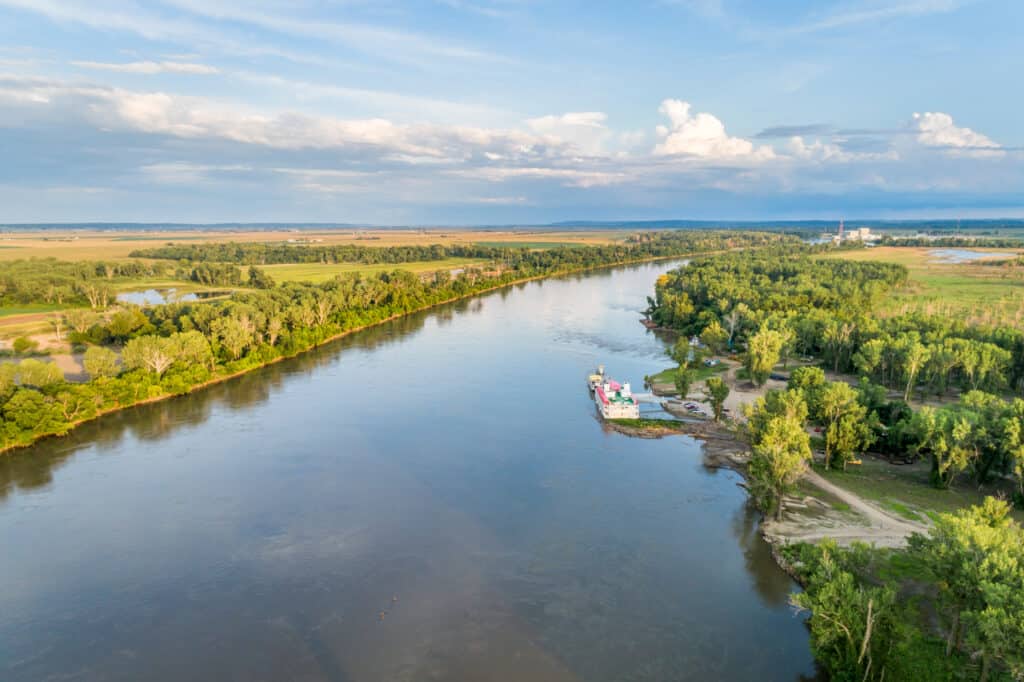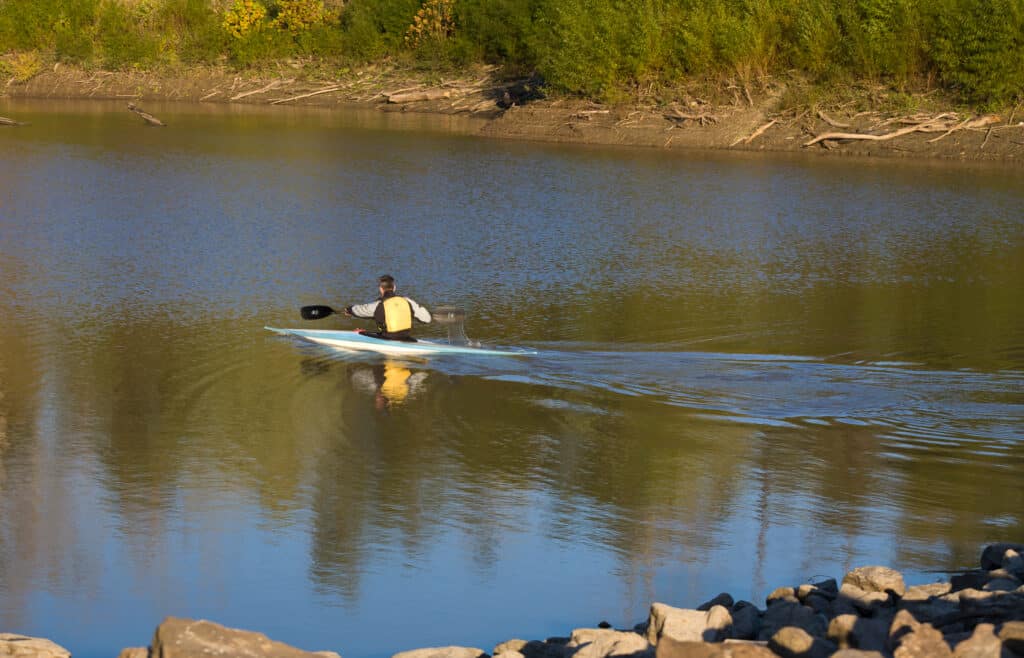Located in the center of the continental United States, Nebraska is an expansive and largely prairie-like state. The Dissected Till Plains region, which covers nearly a fifth of the state’s land area, is characterized by rolling hills crisscrossed by streams and rivers. In the northern section of Dissected Till Plains lies the Loess Hills region, with its distinctive large expanses of loamy dusty landscapes distributed by wind over time. To the west lie the vast Great Plains of Nebraska, comprising much of the state’s terrain. As beautiful as this state is, where is the lowest point in Nebraska? Stay with us as we explore this vast state together.
Nebraska Elevation Levels – Lowest Point
The state of Nebraska is home to various landscapes and elevations. Nebraska holds an allure of solitude from the low-lying prairies in the east to the rolling hills and mountains of the surrounding regions. The lowest point in Nebraska occurs along the Missouri River, at an elevation of just 840 feet. This low point along the river lies in the southeastern section of Richardson County. In comparison, the highest point in the state – Panorama Point – stands at 5,424 feet above sea level. Overall, Nebraska has an average elevation of 2,600 feet above sea level. Additionally, this Midwestern state is home to many major rivers and lakes, including the Missouri River, Niobrara River, Platte River (Nebraska’s official state river), and Lewis and Clark Lake.

Nebraska’s lowest point lies along the Missouri River at 840 feet and its highest place is Panorama Point at 5.424 feet above sea level.
©marekuliasz/Shutterstock.com
How Did the Missouri River Get Its Name?
The Missouri River is one of North America’s longest and most significant rivers. It covers over 2,500 miles, from its Rocky Mountain headwaters to its mouth on the Mississippi River. This river is steeped in history and is the centerpiece in the historical fortunes of various Native American groups. Many of these native American groups lived along its banks and thrived on its natural resources. Also, the Missouri River is the foundation of economic development in modern-day America. But where did the Missouri name originate?
There is some debate among historians about this question. Still, most agree that it derives from two different Algonquian terms. The one term, emessourit, refers to people with canoes crafted from logs. The other term, Pekitanoui, was a name given to the river itself. Both terms were first mentioned in 1673 by the French explorer and cartographer Jacques Marquette. He used them to refer to the river and the Native American tribes along its banks. Through continued use by other explorers and mapmakers over the decades, these two names eventually merged into one, the Missouri River.
Where Is Richardson County Located on a Map?
Richardson County lies directly south of Auburn, a small city formed from the fusion of two towns, Calvert and Sheridan in the late 19th century.
It also lies directly to the north of Sabetha, a small manufacturing town which is located north of Seneca.
The Formation of the Missouri River
The formation of Nebraska’s lowest point, the Missouri River, is an incredibly complex and fascinating process that has taken millions of years to unfold. This remarkable geographical feature began to take shape after a vast expanse of shallow seas covered North America. Over many eons, the sea eventually gave way to tropical jungles and savannas, and the land started moving northward.
But ultimately, all this activity was interrupted by massive glaciers pushing their way down from the Arctic regions. These enormous ice sheets left their mark on much of the northern Great Plains before eventually receding. And while they didn’t reach as far south as the Missouri River today, they certainly had a significant impact on what would become this great waterway. Thus, Nebraska’s lowest point formation is a fascinating phenomenon that offers insight into the Earth’s rich and varied history.
Benefits of the Missouri River for Nebraska
The benefits of the Missouri River to Nebraska are numerous and far-reaching. As one of the nation’s most important rivers, it has historically served many roles that continue to this day. For example, the river provides vital agricultural irrigation in Nebraska, helping support local farms and rural communities. It also serves as a valuable source of hydroelectric power, providing clean and renewable energy for homes and businesses throughout the state.
Furthermore, the Missouri River plays a critical role in flood control for Nebraska communities. Thanks to its wide channel and natural floodplain, the river can absorb excess water during heavy rains or spring snowmelt without causing damage to nearby towns or cities.

The Missouri River provides natural floodplains, absorbing excess water from heavy downpours and spring snowmelt.
©LanaG/Shutterstock.com
Recreational Activities – Missouri River, Nebraska
The Missouri River and surrounding area are fantastic places for outdoor recreation. Missouri will accommodate your passion if you are interested in boating, birding, camping, canoeing, and kayaking. And if you prefer fishing, hiking, biking, or hunting, there is something to suit every taste along the river.
The Big Muddy is renowned for its scenic landscapes and abundant wildlife. So, explore the nature trails along the shoreline or brave the rapids in a canoe or kayak. Whatever your outdoor interests, you will undoubtedly encounter plenty of opportunities for exploration and discovery along and on this massive waterway.
The Missouri River’s Impact on Tourism in Nebraska
The Missouri River is a defining feature of the state of Nebraska. It is known for its many recreational opportunities and unique historical significance. Originating as the Upper Missouri River in Montana, it cuts through the rugged terrain of the Rocky Mountains. From there, it winds its way down into sparsely populated agricultural areas in northern Nebraska.
The Missouri River offers endless opportunities with its vast and twisting channels, gentle rapids, and braided streams. Undoubtedly, tourism in Nebraska plays a crucial role in the state’s economy. Over 6.5 million people visit this vibrant state each year. As a result, tourism creates over 40,000 jobs and generates nearly $3.4 billion in earnings. This number continues to grow as more and more people are drawn to the beauty and cultural significance of the Missouri River.
The rich history of the Missouri River also makes it a focal point for visitors to Nebraska. For example, past generations fought significant battles during the American Civil War on or near this iconic waterway. And Native American tribes such as the Oto and Missouri saw this region as their traditional homeland for centuries before Europeans arrived on these shores.

The lowest point of the Missouri River and other areas along this waterway attracts 6.5 million visitors annually and generates almost $3.4 billion.
©Leonard Jerry Horsford/Shutterstock.com
Interesting Places Near the Lowest Point in Nebraska
This iconic body of water, near the Missouri River’s lowest point, will leave a lasting impression on avid outdoors enthusiasts. Or, if you are interested in learning about Nebraska’s rich history and culture, reading up about the lowest point and others around this iconic river should be riveting. Until then, the following attractions see droves of visitors each year:
Niobrara State Park
Located on the scenic northeastern border of Nebraska, Niobrara State Park is an ideal destination for anyone looking to explore the great outdoors. With a range of accommodation options, from cabins and RV camping to tents and picnic areas, there is something for everyone here. Niobrara caters to all recreation needs, from swimming in the park’s pool during summer to fishing on the river banks or exploring winding trails on horseback.
Ponca State Park
Suppose you’re looking for an exciting place near the Missouri River in Nebraska. In that case, there are few better options than Ponca State Park. This park offers numerous outdoor recreation and nature exploration opportunities in its location at the scenic bluffs along this iconic river. Whether you want to spend time camping, horseback riding, fishing, or merely appreciating the spectacular views of the river valley, Ponca State Park is an idyllic spot. It offers enriching and memorable experiences near the Missouri River.
Wildlife in and Near the Missouri River
The Missouri River is a truly vital and dynamic ecosystem. This ecosystem near Missouri’s lowest point offers open waters, sandbars, wetlands, and forest habitats to an incredibly diverse range of wildlife species. Over 300 birds make their homes on or near the river. Some of these include songbirds like the olive-sided flycatcher and Bewick’s wren and raptors like the bald eagle and peregrine falcon.
One hundred and fifty-six fish species live in the waters of the Missouri River. You will find anything from game fish, such as bass, to bottom feeders, like catfish and sturgeon. Other creatures that thrive in this unique ecosystem include 60 species of mammals like beavers, otters, muskrats, mink, and stoats. Lastly, 52 distinctive reptile and amphibian species also call this area home. There is no better place to experience nature than near the lowest point of the incredible Missouri River in Nebraska or any other location along its banks.
The photo featured at the top of this post is © marekuliasz/Shutterstock.com
Sources
- NETSTATE, Available here: https://www.netstate.com/states/geography/ne_geography.htm
- NAMES, Available here: https://ans-names.pitt.edu/ans/article/view/1561
- Nebraskastudies.org, Available here: https://nebraskastudies.org/en/pre-1500/the-ice-age/
- Papio-Missouri River Natural Resources District, Available here: https://www.papionrd.org/flood-control/missouri-river-projects/
- Nebraska Tourism Commission, Available here: https://visitnebraska.com/annual-reports/nebraska-tourism-commissions-2021-annual-report
- National Park Service, Available here: https://www.nps.gov/mnrr/planyourvisit/nearby-parks.htm
- University of Nebraska Lincoln, Available here: https://digitalcommons.unl.edu/usarmyceomaha/47/
Thank you for reading! Have some feedback for us? Contact the AZ Animals editorial team.






